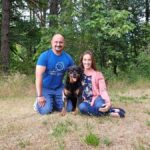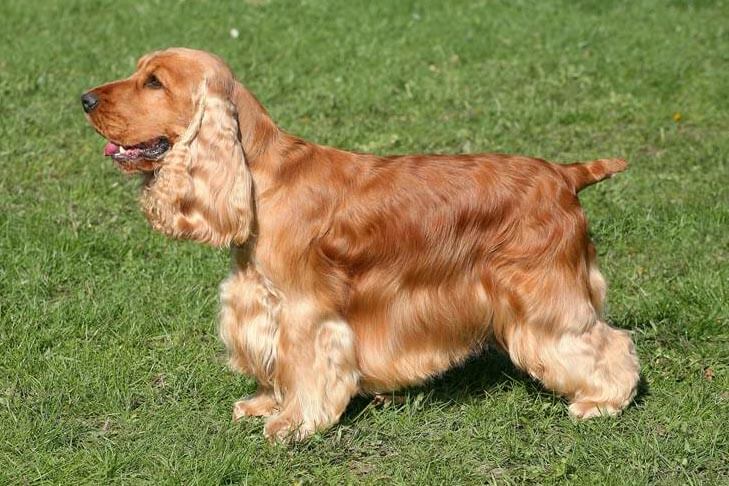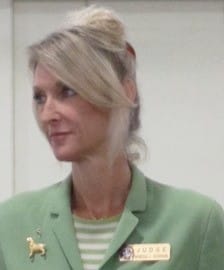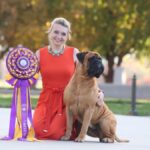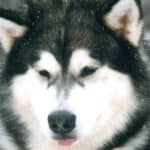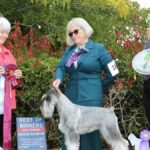Interview with Sporting Group Judge Marissa Clark by Showsight Magazine.
1. Where do you live? How many years in dogs? How many years as a judge?
2. What is your original breed? What is/was your kennel name?
3. Can you list a few of the notable dogs you’ve bred? Any performance or field titles?
4. How important are Performance and Companion titles in a Sporting Dog?
5. Have you judged any Sporting Breed Specialties?
6. Do you find that size, proportion, and substance are correct in most Sporting breeds?
7. Is breed-specific expression important to you as a judge? Can you offer some examples?
8. What are your thoughts on the current grooming practices among the coated breeds?
9. Are the Sporting breeds in good shape overall? Any concerns?
10. In your opinion, how do today’s exhibits compare with the Sporting Dogs of the past?
11. Why do you think the Sporting breeds make up a large portion of the typical show’s entries?
12. Just for laughs, do you have a funny story you can share about judging the Sporting Group?
Sporting Group Judge Marissa Clark
I have bred multiple BISS and Group-Winning/Placing English Cocker Spaniels under the “Marimac” prefix. I was the Sporting Group Director for an all-breed club, taught an all-breed handling class for eight years, managed a veterinary practice, owned a large grooming shop, apprenticed for several top handlers, and handled professionally before becoming a judge in 2003. I am a Board Member for the English Cocker Spaniel Club of America, am active on the BEC/JEC Committee, and am an approved mentor/seminar presenter. I maintain memberships with the American Dog Show Judges, Inc. and the Oregon Dog Judges group. I currently judge the Sporting, Working, and Toy Groups, Best in Show, Miscellaneous, and a few other breeds. I was a Junior Handler and enjoy judging them, as they are the future of our sport. My father, Doug McFarlane, also judges, and I enjoy the family involvement that this sport affords. I love theater, being outdoors with nature, and ALL animals.
Where do I live? How many years in dogs? How many years as a judge? I live in Gig Harbor, Washington. I am a native of Southern California and moved 11 years ago, realizing my childhood dream of living in this beautiful state, where trees, seasons, and wildlife are abundant. Regarding my years in dogs, as we ring in 2022, I will have 50 years under my belt in the sport. I have been judging since 2003. I am fascinated to learn about a breed’s history, reason for development, and purpose.
What is my original breed? What is/was my kennel name? Our original breed was the Irish Setter. We obtained an Irish bitch from the late Joyce Nielson of Thenderin fame. “Kate” became my Juniors dog. We had three Irish before deciding to downsize to English Cocker Spaniels. Our litter of 13 Irish puppies redesigned the backyard with their jovial rompings! The love for the breed has not waned and my parents would love another redhead to add to the family of Cockers. We will see where that takes us!
Our kennel prefix is “Marimac,” incorporating Mar/Mari and Mac… the Mari for Marissa (Mar for Marleta, mother’s first name) and Mac for McFarlane, my maiden name. My parents and I have maintained our breeding program together since 1971. I teasingly say that there is one VERY well-rounded dog person if combining the three of us! Maybe that is debatable!!!
Can I list a few of the notable dogs I’ve bred? Any performance or field titles? We have produced many BISS/Group-winning and placing English Cockers, both in Solid and Parti-Colors. With showing, judging, and grooming/maintaining the dogs, I believe it is time to focus more on judging and less on our breeding program.
I earned a WD/WDX on our first English Cocker, an Orange Roan, who was the most stubborn dog we have owned to date! “Beau” lived life on his time, in his way! He was heavy-mouthed and never wanted to give up the birds, and he hated the water retrieves! This was not an easy dog to train! I definitely worked to get inside Beau’s head to earn those titles!
I have also earned a CD/CDX in Obedience with one of our (American) Cockers. He was a “natural,” so intelligent and wanting to work and please. His first weekend out, he competed at a specialty, receiving a 198 score and High in Trial! The following two days, he earned scores of 197 and 196-1/2 for his CD title. This same dog, “Bolt,” also competed in Agility, earning the titles to take him to MACH level competition. He was unbelievably fast and every bit a multiple MACH dog, but I ventured off that path after getting divorced and bought a large grooming shop that disrupted that process. To this day, I feel guilty for not continuing with his true love and desire. Agility Trials ceased, and he became the “meet and greet” dog of the grooming shop.
How important are Performance and Companion titles in a Sporting Dog? There are so many ways that people can enjoy their dogs at AKC events today. I have great respect for the Sporting Dogs that are multi-titled. Brittanys and Vizslas are greatly focused on dual titles. I remember working the Cockers in the field and admiring the natural instinct and drive these dogs have. I believe that keeping instinct alive is a very important aspect of breeding dogs. It is so important to breed to a standard, having a structurally sound dog that is also a working companion. No doubt, dogs with tremendous heart and a burning desire can—and do—succeed in the field, but the less structurally sound dogs must compensate to the best of their ability and cannot compete without the proper physical make-up. A dog that is not structurally sound leads to injury, weakness, and chronic conditions of the musculoskeletal frame, soft tissue, and ligaments. A well-made dog can work all day! And, with correct structure, these wonderful companions can live life well into their senior years without horrible pain due to “body breakdown.” We are the voice for our dogs. It is our responsibility to make every attempt to breed proper dogs that are sound—both of body AND mind.
Have I judged any Sporting Breed Specialties? I have been privileged to judge many Sporting Dog specialties. Some of the best dogs in a breed are seen at specialties, since not all breeders or owners have the means to campaign their dogs. Many times, great dogs are finished then placed in homes or used in a single breeding program. Dogs may be forgotten by peers, not seen from coast to coast or shown long enough past their championship to get exposure. Specialties afford peers to see other options for breeding. Specialties should bring peers together, where open and honest discussions regarding health and structural integrity can help to propel a breed forward, maintaining current strengths and working on improvements where weaknesses in a breed is apparent. A perfect example of this is the Golden Retriever, a largely popular breed. I am greatly impressed with these breeders who take the time to educate a prospective judge. As a whole, peers set-aside their differences and have one goal; that of educating, and hopefully, forming a good, solid judge for their breed.
Do I find that size, proportion, and substance are correct in most Sporting breeds? This is a great question! It is, however, truly difficult to lump ALL Sporting Dogs into a neat package to answer this question.
Size: MOST of our Sporting Dogs are within their size range. I rarely see “too small” a dog over “too tall” a dog. There are several breeds I’ve observed that are prone towards too large; notably, the German Shorthaired Pointer, Weimaraner, Vizsla, and (American) Cocker Spaniel. To maintain breed type, dogs should be within the desired size of each written standard.
Proportion: Many times, when proportions are off, there will be too much length of loin. Length should be in the rib, not in the loin. (There are a few breeds where length is allowed, or bitches may be given a bit more length in loin.) As a general comment, too much length of loin can look great on the go-around, lending to an open and expansive gait—even when the standard does not state such. Dogs with too much length in loin cannot work all day. This animal will break down. He is a capable sprinter, not a long-distance runner. He will tire easily and is prone to injury. Many times, these dogs are two-piece dogs, where balance, front to rear, is compromised. Also, they don’t fit into the standard’s verbiage of square, off-square, rectangular, etc.
Substance: I see lack of substance (too fine) more times than too much substance. Generally, the word “moderate” is used in our standards. Never do you see a standard suggest extremes. It is human nature to push dogs to be “flashy” and “showy,” with a huge, open, expansive gait… but, are these words in the standard? I think not! In fact, a Brittany’s or a Vizsla’s open, ground-covering gait is quite different than the ground-covering gait of Spaniels, or the very unique gait of the Spinone. The English Cocker does not have the rear kick of his cousin, the (American) Cocker. However, this does by no means alter the statement, “least amount of steps, covering the most ground.” Substance in the Spaniel is not the same substance as in the pointing or retrieving breeds. In fact, bone shape is not the same either. Human nature is to lean towards flashy and showy, and a huge, open gait, head held high… and on and on. Moderation cannot be stressed enough.
To put this question in perspective, I believe that size, proportion, and substance are key to proper “type.” You cannot have one without the others. As I always say, there ARE many “styles” but there is only one “type.”
Is breed-specific expression important to me as a judge? Can I offer some examples? In regard to breed-specific expression, without a doubt, expression is very important. Without it, you have a generic dog of the breed. Proper expression and breed type go hand in hand. An example would be a standard stating “soft and melting” expression with a deep set, dark, oval eye desired… instead, you see a dark, protruding, round eye that jumps out at you. By no means can that eye produce the correct expression stated in that breed’s standard. Again, our standards set each breed apart. Expression to me is the frosting on the cake. (And, if I am going to eat cake, I need that frosting!) Expression cannot be forfeited. On a correct headpiece, expression is essential to correct type!
What are my thoughts on the current grooming practices among the coated breeds? Regarding grooming practices among coated breeds, here again is where the standard comes into play. Recently, several parent clubs have produced educational materials begging attention be paid to over-grooming practices seen currently. If you have a double-coated Sporting Dog that works in water, but the undercoat has been stripped out, it will indeed affect performance in the field. He will get cold, bogged down, wet to the bone, and will not be able to “run all day!” I believe that checking the coats of the breeds is very important. Although there has always been a push to perfection of presentation, form and function is where the focus must lie! I can get past a badly groomed dog, with too much coat, over an over-groomed—or not breed-specific groomed—dog. I have a vast appreciation for a dog that is well-groomed, but overgrooming (where extreme angles are built into the dog) or using products to make a coat something it is not, is not acceptable. And this is our responsibility—the judges—to recognize these things. Our hands must speak to us. There are unbelievably talented groomers who can literally make a dog completely different than what its make and shape truly are!
Are the Sporting breeds in good shape overall? Any concerns? I feel there are too many shows today, and this lends to a dilution of quality—especially at smaller shows. With regard to Sporting Dogs’ overall quality today, I do have concerns. These are no different than what the other Groups are dealing with, i.e., fronts, proper coats, feet, toplines, croups, second thighs, and overall balance… and the most important, “proper breed type.” (My responses below continue with other ponderings.) Breeding dogs is not for the faint of heart, and a willingness to put in the time, a slow and steady approach, and patience are all necessary. If you stay in this sport long enough, you won’t go unscathed. Learn, ask questions, and be humble. Nobody always gets it right. Learn from the older and more seasoned breeders and handlers. They are a wealth of information. Don’t be shy… they aren’t going to find you. You have to find them! Even after 50 years, when we are considering a breeding, we ask our trusted peers about that dog. (It pays to have many eyes and ears!)
In my opinion, how do today’s exhibits compare with the Sporting Dogs of the past? Today’s dogs, as compared to the past dogs, have one defining difference… large kennel operations where breeders could experiment more. Gone are most 25-45+ animals in a breeding program. Those people of the past could develop many masterful combinations as well do “hunch” and experimental breedings. Today’s breeders are mostly hobbyists with small-scale operations. By no means can this possibly yield the consistency seen in years past. Quality then was such that by seeing an entry at a show, one could determine the prefix of the animals’ lineage. Our Sporting Group was so very strong many years ago, rich and deep in both Breed and Group competition. There were many great mentors to learn from too. In my opinion, the true understanding of a breed today is less than what it once was. Generally, today, folks want to finish a dog rapidly, breed it, and move on to the next. Gone are the days of sitting around the rings all day until Best in Show was over, or hanging out at the motorhomes with the handlers, breeders, and assistants, dissecting dogs well into the night. I am so honored to have been a part of those special days. They were great times for camaraderie, growth, and development. The day’s competition—its winners and hopefuls—were set aside. Discussions well into the evenings were offered freely and for the sake of promoting properly made dogs. Today, mentors are few and far between. In the past, one had to pay your dues. Your responsibility was to seek out mentors and then PROVE you were truly interested and vested. I am so fortunate to have known, as well as assisted, some of the best our sport has had. These people were gifts. If I wished for one change for the newer people to this sport, it would be that they seek out highly capable mentors; pick their brain, learn from them, assist them with their breeding practices, and learn how to properly groom and present the breed. This is a time-consuming process. Why not take the time to find those who have had that success? Education is key to knowledge and success. We have fewer breeders today that CONSISTENTLY produce beautiful, quality dogs. Many times, we are judging dogs with too many variations of size, shape, and proportion. Breed type can be hard to find at some smaller shows. This is a far cry from the days at Del Valle, Spaniel Club, and other large shows where classes were rich and deep in quality and consistency… where some classes were about splitting hairs to be awarded the win. And, what an honor it was to eke out that win. It made better breeders, to be sure!
I will say that there are breeds making great progress today. Two examples come to mind: The Setters are realizing better fronts. Kudos to their breeders for seeing where they needed to improve and for seeing their hard work pay off; and American Cockers are coming back from the exaggerated, long, sweeping stifle/rear.
Temperaments in Sporting Dogs have always been solid. I will say that a few of our current Sporting breeds have either softer or mistrusting temperaments that are needing to be addressed. We cannot lose the wonderful temperaments possessed by this Group. You never had to worry about approaching a Sporting Dog, looking them in the eye, and enjoying their wonderful response to your attention. Let’s keep it that way!!! This Group should have stable temperaments to be enjoyed!
Why do I think the Sporting breeds make up a large portion of the typical show’s entries? Regarding why Sporting Dogs make up a large portion of show entries… this is an easy one to answer. It’s because they are truly wonderful! Who wouldn’t enjoy living with a Sporting Dog! As I said above, this Group is made up of kind, loving, and level-headed dogs. It would be a shame to change this.
Just for laughs, do I have a funny story I can share about judging the Sporting Group? I do not have a funny story. However, I will say, anyone who has had an 8:00 AM judging assignment with Labradors as the first breed cannot help but smile and enjoy the start to your day. As we know, dogs teach us many things—if only we choose to listen. Labradors are a reminder that you should never take life too seriously. They are a wonderful example of happiness with the simple things in life. I cannot help but say hello to each exhibit and watch each dog wiggle its rear end, opposite the front, while producing a big grin, showing sheer happiness oozing from every pore. Now, that makes my day!
